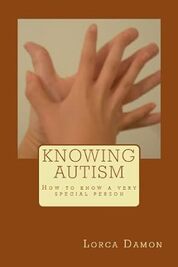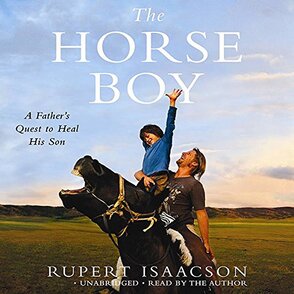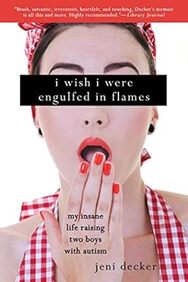What is the most concerning or destructive thing that is going on right now in your child’s world?
SENSORY ISSUES
I know this is hard for you and me to comprehend, but we are “talking serious physical pain here.” Not a mild irritation that one can live with, but serious physical pain from wearing a shirt with a scratchy tag or from hearing the sound the refrigerator makes, even though the kid is in the living room.
Sicile-Kira (2014) tells us that a typical characteristic of children with autism is “to become stiff when held, and does not like to be touched.”
Being touched triggered flight, it flipped my circuit breaker. I was overloaded and would have to escape, often by jerking away suddenly (from Temple Grandin, Thinking in Pictures).”
Another excerpt from Sicile-Kira tells us that “Some babies become stiff when you pick them up… usually this indicates that their tactile sense is out of whack.” She also tells us that when interviewing Temple Grandin, “From as far back as I can remember, I always hated to be hugged, but it was just too overwhelming…
Howe & Stagg (2016) cite the sensory pain of hugging as to be so stressful as to cause real pain to the recipient. Some say that being hugged made them lose concentration, ‘feel tired’ and was physically uncomfortable to the degree that it could bring on severe anxiety.
Contrary to this, some children experience sensory-seeking behavior which is only satisfied by deep pressure hugs. Almanza (2014) quotes the same Temple Grandin who despised ‘hugging’ as saying that she designed a “squeeze machine” in her head to artificially suppress sensory overload. The famous machine allowed the user to experience deep pressure on both sides of the body, in order to relax and control her neurosensory experiences.
Autistic brains, it turns out, have a much greater number of nerve cells than ‘neurotypical’ brains. The result for the child can be extreme sensory overload.
A breath of wind on Rowan’s cheek could feel like fire from a flame-thrower. The fluorescent light of a supermarket or day-care facility could look like lights of a ‘strobed’ light at one million times a second.
His clothes or bedcovers could suddenly, if the wrong neurological switch was thrown, feel like lead weights or burning napalm.
Ashburner, J. et al. (2013), in an article about sensory issues and targeting self-regulation intervention allows that…
“Children with ASD have differences in processing language, auditory and visual information entering their brains. Their sensory profile can be determined by questioning the child, if they are verbal. “You are covering your ears? What makes them hurt?” “You are rubbing your eyes?” What makes them burn?” Of course, the child may not identify what it is, but you can probably figure it out.”
The article explains the Sensory domains as –
“Sound sensitivities…scraping sounds, clock ticking, high-pitched sounds whistling, baby crying, or hair dryers. But the ASD child will make their own irritating (to us) sounds over and over again.”
“Visual sensitivities…bright light, flashing lights, TV and computer screens. But the ASD child will look at patterns and moving fan blades until forever.”
“Taste sensitivities…chemical smells, sour foods, some vegetables and cheeses. But a child with ASD will only eat those foods they crave, regardless of how it seems to us. Or, crazy combinations like pickles and ice cream.”
“Texture sensitivities…rubbery, crunchy, rough, tags and seams on clothes. But a child with ASD will shovel in chips and French fries, non-stop. They will rub, lick and smell the carpeting in their room.”
“Smell sensitivities…cigarette smoke, animal smells, perfumed products. But a child with ASD will like to smell your cup of coffee or tea.”
This information from Ashburner’s article lets us begin to see the sensory troubles that children with ASD could face.
Knowing this helped us to understand a little of what we were dealing with.
Merchant, T. (2007) 10% “He’s not autistic, but…” I kept hearing myself say as I explained Clay’s behavior, illnesses, inability to sleep through the night, and sensory issues.
< My Thoughts > “He’s not autistic, but…” I kept hearing myself say as I explained Clay’s behavior. The child can be experiencing extreme sensory overload.
Ventola, et al. (2006) claim in their study that 195 children that have failed to be diagnosed with ‘autism’ have ‘something else’. Something that is consistent with impairments in socialization skills, joint attention skills and some aspects of communication, play, and sensory processing. They go on to say that these children have developmental delays, but are ‘less’ impaired than those who met the criteria for Autism Spectrum Disorder. These children seem more adaptable than the ASD children, although they share the same behavioral differences.
< My Thoughts > “…huge set of noise-reducing headphones.”
Gee, et al. (2013) believe that when sensory processing is impaired it impacts a person’s daily routine. That when the environment is acoustically modified with music, delivered using specialized headphones and a CD player, it can help children with autism cope. Auditory hypersensitivity and abnormal responses to sounds that are neither threatening nor uncomfortable for most can cause behavioral disturbances in people with ASD.
While the study states that headphones playing music may not work for all those trying to cope with sensory processing issues, it seems to work for many. As a parent and educator, I am continually aware of filtering interventions through the process of what is ‘age appropriate’. And, I know that getting someone to accept an ‘earbud’ placed in their ear would require a careful learning-acceptance process, over time. But, everywhere you look today, you will see students and adults with that white cord dangling from their ear as they listen to their tunes.
Decker, J. (2011) 11% In elementary school, the counselors tried to solve Jake’s sensory overload by giving him a huge set of noise-reducing headphones. Yeah, that was nice. Now he not only didn’t fit in, but he had a monstrous set of yellow earphones to even further separate him from his peers. He looked like a big, sweaty bumblebee. Eventually they were replaced with orange ear plugs that he now wears in the gym, in the noisy hallways, and often in class. Add a mini bottle of antibacterial gel to his arsenal of protection, and all he needs is a pocket protector and a lisp and he’s right out of central casting for Nerds III. “I am the Walrus, goo goo ga joob.”
< My Thoughts > “…huge set of noise-reducing headphones.”
Gee, et al. (2013) believe that when sensory processing is impaired it impacts a person’s daily routine. That when the environment is acoustically modified with music, delivered using specialized headphones and a CD player, it can help children with autism cope. Auditory hypersensitivity and abnormal responses to sounds that are neither threatening nor uncomfortable for most can cause behavioral disturbances in people with ASD.
While the study states that headphones playing music may not work for all those trying to cope with sensory processing issues, it seems to work for many. As a parent and educator, I am continually aware of filtering interventions through the process of what is ‘age appropriate’. And, I know that getting someone to accept an ‘earbud’ placed in their ear would require a careful learning-acceptance process, over time. But, everywhere you look today, you will see students and adults with that white cord dangling from their ear as they listen to their tunes.
Luker, S. (2014), For further information on Sensory Issues, please find the following on my website MENU -
UNIT 4 – When Is It Sensory?
UNIT 4 – INTRODUCTION
UNIT 4 – CHAPTER 1 – Sensory Issues
PART 1.
a. Sensory Defensiveness
b. Sensory Avoidance
UNIT 4 – CHAPTER 2 – Sensory Categories
PART 1. HYPO-ACTIVITY
PART 2. HYPER-ACTIVITY
PART 3. SIRS (Sensory Interests, Repetitions, & Seeking behaviors)
a. Sensory Interests
a. 1. SIBs Self-Injurious Behaviors.
b. Repetitious Behavior
c. Seeking Behavior
PART 4. ENHANCED PERCEPTION
APPENDIX –
UNIT 4 – CHAPTER 3 – Sensory Integration
PART 1. Sensory System
PART 2. Sensory Profile
PART 3. Sensory Diet
a. Brushing Techniques
PART 4. Sensory Room
References:
Almanza, M. (2014). Temple Grandin’s Squeeze Machine as Prosthesis; Joural of Modern Literature; V39, p162-174.
Ashburner, J., et al. (2013). Understanding the sensory experiences of young people with ASD: A preliminary investigation; American Journal of Occupational Therapy.
Decker, J. (2011), I Wish I Were Engulfed in Flames: My Insane Life Raising Two Boys with Autism; eBook Edition.
Damon, L. (2012). Knowing Autism; eBook Edition.
Gee, B., Thompson, K., St. John, K. (2013). Efficacy of a Sound-based Intervention with a Child with an Autism Spectrum Disorder and Auditory Sensory Over-responsivity. Occupational Therapy, Int. 21:12-20.
Howe, E., & Stagg, S. (2016). How Sensory Experiences Affect Adolescents with an Autistic Spectrum Condition within the Classroom; Journal of Autism & Developmental Disorders;V46, p1931-1940.
Isaacson, R. (2009). The Horse Boy; eBook Edition.
Luker, S. (2024). Know Autism, Know Your Child with < My Thoughts > by Sara Luker; Retrieved online from – www.sarasautismsite.com
Merchant, T. (2007). He’s Not Autistic, But…How We Pulled Our Son from the Mouth of the Abyss; eBook Edition.
Sicile-Kira, C. (2014). Autism Spectrum Disorder (Revised): The Complete Guide to Understanding Autism; New York, New York: Penguin Random House Company.
Note: DISCLAIMER – Autism ‘intervention’, as with the phrase ‘Early Detection / Early Intervention’, may simply mean to attempt an ‘action’, or attempt to ‘change a course’ or ‘trajectory’ of the person’s autism. Any expectation for a successful ‘change’ must have the cooperation of the participant, the parent, and/or the assigned therapist. Words such as, ‘intervention’, ‘treatment’, ‘therapy’, ‘service’, or ‘program’ imply ‘cure’, or ‘long-term’ positive effect. That is NOT my intention here, and all information is presented without intent or suggestion of status or effectiveness.
End of DAY THIRTEEN. Note: Excerpts from the books – (13% indicates location in the Kindle version of the eBook, instead of page numbers).
Sharing of my website and BLOG Comments welcomed. Thank-you to those of you who have sent comments... much appreciated!
Regards,
Sara Luker
References:
Almanza, M. (2014). Temple Grandin’s Squeeze Machine as Prosthesis; Joural of Modern Literature; V39, p162-174.
Ashburner, J., et al. (2013). Understanding the sensory experiences of young people with ASD: A preliminary investigation; American Journal of Occupational Therapy.
Decker, J. (2011), I Wish I Were Engulfed in Flames: My Insane Life Raising Two Boys with Autism; eBook Edition.
Damon, L. (2012). Knowing Autism; eBook Edition.
Gee, B., Thompson, K., St. John, K. (2013). Efficacy of a Sound-based Intervention with a Child with an Autism Spectrum Disorder and Auditory Sensory Over-responsivity. Occupational Therapy, Int. 21:12-20.
Howe, E., & Stagg, S. (2016). How Sensory Experiences Affect Adolescents with an Autistic Spectrum Condition within the Classroom; Journal of Autism & Developmental Disorders;V46, p1931-1940.
Isaacson, R. (2009). The Horse Boy; eBook Edition.
Luker, S. (2024). Know Autism, Know Your Child with < My Thoughts > by Sara Luker; Retrieved online from – www.sarasautismsite.com
Merchant, T. (2007). He’s Not Autistic, But…How We Pulled Our Son from the Mouth of the Abyss; eBook Edition.
Sicile-Kira, C. (2014). Autism Spectrum Disorder (Revised): The Complete Guide to Understanding Autism; New York, New York: Penguin Random House Company.
Note: DISCLAIMER – Autism ‘intervention’, as with the phrase ‘Early Detection / Early Intervention’, may simply mean to attempt an ‘action’, or attempt to ‘change a course’ or ‘trajectory’ of the person’s autism. Any expectation for a successful ‘change’ must have the cooperation of the participant, the parent, and/or the assigned therapist. Words such as, ‘intervention’, ‘treatment’, ‘therapy’, ‘service’, or ‘program’ imply ‘cure’, or ‘long-term’ positive effect. That is NOT my intention here, and all information is presented without intent or suggestion of status or effectiveness.
End of DAY THIRTEEN. Note: Excerpts from the books – (13% indicates location in the Kindle version of the eBook, instead of page numbers).
Sharing of my website and BLOG Comments welcomed. Thank-you to those of you who have sent comments... much appreciated!
Regards,
Sara Luker



 RSS Feed
RSS Feed